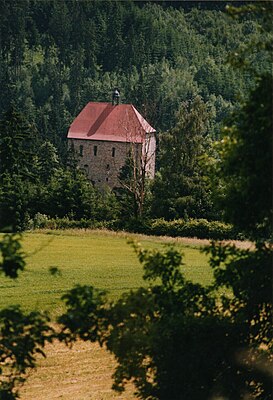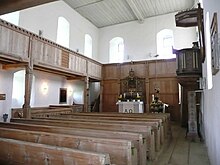Stein Castle (Gefrees)
| Stein Castle | ||
|---|---|---|
|
Castle chapel stone |
||
| Creation time : | around 1000 | |
| Castle type : | Höhenburg, spur location | |
| Conservation status: | Kemenate and remains of the wall | |
| Standing position : | Allodialburg | |
| Place: | Gefrees , district of Stein | |
| Geographical location | 50 ° 3 '43.8 " N , 11 ° 42' 11.4" E | |
| Height: | 460 m above sea level NN | |
|
|
||
The castle stone , mostly from today only the castle chapel , the former bower is obtained, was a very early castle of Walpoten . It is located in the Stein district of the town of Gefrees , Stein 32, in the Upper Franconian district of Bayreuth in Bavaria , Germany .
Geographical location and description
The spur castle is located on a spur that protrudes to the southeast, is somewhat constricted and wooded at the back, above a loop of the Ölschnitz , which is a little over 420 m above sea level below . NN flows to the southwest on a larger scale. The associated settlement begins about 100 meters back from the castle grounds on the again widening higher and already quite flat slope and extends up to about 500 m above sea level. NN .
Only the bower, a three-storey building from the 14th century, which today bears a high half- hipped roof erected in the 17th century, is completely preserved of the former castle . The St. Michael chapel, which was established in 1686, is located on its upper floors. Parts of the defensive walls and fragments of the former castle chapel, the kennel and the outer bailey have been preserved . A preserved archway is marked with the year 1548.
The Bavarian State Office for Monument Preservation has registered Stein Castle in the Bavarian list of monuments under the number D-4-72-139-26 as a monument (landscape -defining monument). The entire castle hill is registered under the number D-4-5936-0068 as a ground monument of the Middle Ages and the early modern period .
As the crow flies, a good 2 kilometers to the southwest near Bad Berneck are the ruins of the Wallenroder castles on an estuary spur above the river .
history
Stein is mainly known for its castle complex, which was probably built around 1000. 1028 was used as free own the Walpoten the Hochstift Bamberg transmitted. Bishop Rupert von Bamberg used the Stein rule around 1077 to found the St. Jakob monastery in Bamberg. Around 1100 the noble Poppo “the white one” from Stein appeared as trustee of the St. Jakob monastery in the Stein rule.
In the 13th or beginning of the 14th century the castle then seems to have become ruinous, because in 1342 it was rebuilt by Heinrich, Friedrich and Heilmann von Hirschberg with the consent of Bishop Leopold von Bamberg . At that time the striking palace was built , which characterizes the view of the castle complex. Stein became the Bamberg border castle against the burgraves of Nuremberg , who had acquired the neighboring Berneck around 1340 . In 1363, Stein changed hands to Rüdiger von Sparneck . His son Hans I. von Sparneck zum Stein entered the service of the Nuremberg burgraves and appeared in 1360 as their bailiff in Hohenberg Castle .
Towards the end of the 15th century the Sparneckers were forced to pawn stone to the Bavarian dukes. Margrave Friedrich I of Brandenburg redeemed the pledges in 1488, so that Stein became the margravial official castle . After the Thirty Years War the condition of the castle buildings deteriorated. In 1684 the official budget was broken up and sold into bourgeois hands.
The cartographer Johann Christoph Stierlein sketched the ruins in detail in 1795. He drew several long defensive walls and outlying outbuildings that no longer exist today. The remains of the castle stand on a rocky elevation above the valley of the Ölschnitz . The core of the castle complex is relatively easy to recognize through several remains of the wall.
Say: The violinist from Stein
It is said that an underground passage leads from the Stein castle ruins to the ruins in Bad Berneck. According to legend, terrible things happen there at night. One day a poor violinist who made his living by making people happy with his music came to Stein. He was very interested in the castle ruins there and so he went there before he moved into his hostel and had a castle guide show him to him. After they had looked carefully at the old walls, they came to the vaulted cellar and when the violinist stopped in front of a huge gate, behind which a ghostly dark throat stretched, he shuddered. When the castle guide saw the fearful face of the young man, he said in a grave voice: “Anyone who walks through this gate will experience the most gruesome things. Things worse than anything he's ever seen before. Apparitions of the dead and ghosts roam down here at night and no one who has ever crossed this door has returned! However, those who survive the horrors in this corridor will be richly rewarded. "
The violinist stood at the gate, torn by fear and the prospect of a decent reward. Eventually, however, the desire for prosperity prevailed and so he opened the huge door and entered the corridor. When the castle guide closed the gate behind the violinist, he was immediately wrapped in an eerie black. Suddenly he saw movement in the darkness of the corridor just a few steps ahead of him! Frightened to death, the man stopped and realized that the gruesome figures were corpses approaching him with rigid movements! Further back he saw a funeral procession with an ancient coffin. The violinist backed away and hoped a redeeming swoon reached out for him, but he stood firm! Finally the funeral procession stopped in front of him, the coffin was opened and he was told to enter! But although he was afraid to think clearly, he resisted the offer and when the frightful figures had recognized that the young man was steadfast, a pale figure, only clad in a shroud, approached him and said without moving his lips: "Before you can ever return to the world of the living, you have to solve one more task!" He handed the man a sack of gold coins and asked him to divide it into two exactly equal parts. Even if the violinist got to work right away, he couldn't solve the problem at first because there was an odd number of coins. He finally took a sharp object out of his jacket and scratched one coin so it could be broken in two. When the dead saw how the man had solved the task, he handed him the sack and released him, where he was welcomed by the castle guide. The man never had to live in poverty again and lived a happy life until his death.
St. Michael Castle Chapel
As early as 1377, a castle chapel built by Hans I. von Sparneck was consecrated in the name of St. Michael . It was located in the area of the kennel immediately before the entrance to the main castle . The ruins of this early chapel can be seen today on the northeastern edge of the castle complex.
Since the turmoil of the Thirty Years' War it has belonged to the evangelical creed. Almost 40 years later, in 1686, the Protestant church bought the Stein castle ruins from the Catholic Archdiocese of Bamberg. The upper floors of the fully preserved multi-storey building of the castle's palas , the so-called knight's house, was redesigned by the bailiff at the time, Johann Jakob Baßler of Basel, into the St. Michael's Chapel, as it is still preserved today. Since then, only the chapel has been structurally maintained, but the rest of Stein Castle has been left to decay.
The altar of the castle chapel comes from Goldkronach . The organ used to belong to a Protestant girls' high school in Taufkirchen.
Stein Castle is now part of the church property of the Bad Berneck deanery , the castle chapel is administered by the Evangelical Lutheran parish of Bad Berneck. Services and other events are held on special occasions.
Individual evidence
- ↑ a b Bavarian State Office for Monument Preservation: Excerpts from lists, Upper Franconia - Bayreuth district, Gefrees (PDF; 135 kB)
- ↑ Bavarian State Office for Monument Preservation: BayernViewer-denkmal ( Memento of the original from April 23, 2016 in the Internet Archive ) Info: The archive link was inserted automatically and has not yet been checked. Please check the original and archive link according to the instructions and then remove this notice.
- ↑ Situation according to Bavaria Atlas of the Bavarian State Government ( information )
- ↑ Hans Vollet, Kathrin Heckel: The ruins drawings of the Plassenburg cartographer Johann Christoph Stierlein. The drawings from the collections of the Bavarian State Library in Munich. (Catalog for the exhibition of the Obermain Landscape Museum on the Plassenburg ob Kulmbach from March 25 to April 24, 1987), Kulmbach 1987
- ↑ Walk through history. St. Michael Castle Chapel. In: Frankenpost from September 19, 2008
literature
- Ruth Bach-Damaskinos, Peter Borowitz: Palaces and castles in Upper Franconia. A complete representation of all palaces, manors, castles and ruins in the Upper Franconian independent cities and districts. Verlag A. Hofmann, Nuremberg 1996, ISBN 3-87191-212-3 , pp. 136-137.
- Tilmann Breuer : District of Münchberg. In: The Art Monuments of Bavaria , Brief Inventories , XIII. Tape. Deutscher Kunstverlag , Munich 1961, pp. 45–47.
- Annett Haberlah-Pohl: The Altlandkreis. ( Historical Atlas of Bavaria , Part Franconia, Series I, Volume 39), Lassleben, Kallmünz 2011, ISBN 978-3-7696-6556-7 , p. 197 ff.
- Markus Thoma: The medieval fortifications in the area around Gefrees. (Gefreeser Geschichte (n), Heft 5), Historisches Forum Gefrees, Gefrees 2011, pp. 23-25.
- Georg Wolf: Stein - a medieval center of power. (Gefreeser Geschichte (n), Heft 6), Historisches Forum Gefrees, Gefrees 2011.
- Ruprecht Konrad-Röder: Markt-Schorgast. History of settlement and rule in the early and high Middle Ages. In: Klaus Ruprecht (Ed.): Marktschorgast 1109–2009. A market town in the course of history. Wissenschaftlicher Kommissionsverlag, Stegaurach 2009, ISBN 978-3-940804-01-3 , pp. 9-30.
- Harald Stark : Castles in the Fichtel Mountains. (Contributions to the history and regional studies of the Fichtelgebirge, No. 10), Kohler, Wunsiedel 1988, pp. 47–51.










